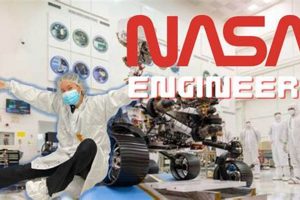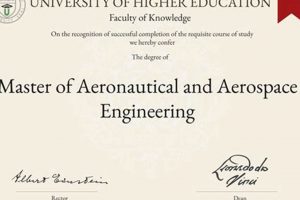The field encompasses the design, development, testing, and production of aircraft, spacecraft, and related systems and equipment. It is a broad discipline that integrates principles from various engineering fields, including aerodynamics, propulsion, structures, materials science, control systems, and avionics. The work involves conceptualizing new vehicle designs, analyzing their performance, ensuring structural integrity, developing efficient propulsion systems, and creating advanced control mechanisms for flight. This often requires intricate computer modeling, simulation, and wind tunnel testing to validate designs before physical prototypes are even created.
Its significance lies in its contributions to national security, transportation, communication, and scientific exploration. Advancements in this area have led to faster and more efficient air travel, the establishment of satellite-based communication networks, and the exploration of space. Historically, it has been a driving force behind technological innovation, pushing the boundaries of what is possible in terms of speed, altitude, and maneuverability. The spin-off technologies developed for aviation and space applications have also found widespread use in other industries, benefiting society as a whole.
Understanding the breadth of this engineering domain requires exploring several key aspects: the specific disciplines involved, the range of projects undertaken, and the future directions of the industry. Subsequent sections will delve into the different branches of specialization, the types of vehicles and systems being developed, and the emerging technologies that are shaping the future of flight and space exploration.
Considerations Within Aerospace Engineering
Effective engagement with aerospace engineering demands a thorough understanding of its core tenets. The following points provide insight into key areas requiring careful consideration.
Tip 1: Master Fundamental Principles: A solid foundation in mathematics, physics, and chemistry is essential. Understanding these principles allows for accurate problem-solving and informed decision-making in complex design scenarios.
Tip 2: Embrace Interdisciplinary Knowledge: This field integrates numerous disciplines. Proficiency in areas like materials science, thermodynamics, control systems, and computer programming is crucial for successful project execution.
Tip 3: Develop Strong Analytical Skills: Analyzing complex systems and interpreting data are paramount. The ability to critically assess performance parameters, identify potential failure points, and propose effective solutions is vital.
Tip 4: Cultivate Effective Communication: Aerospace engineers collaborate within multidisciplinary teams and communicate findings to stakeholders. Clearly articulating technical concepts, both verbally and in writing, is indispensable.
Tip 5: Maintain Rigorous Attention to Detail: Precision is paramount in aerospace applications. Errors can have catastrophic consequences. Meticulousness in design, analysis, and testing is non-negotiable.
Tip 6: Stay Abreast of Technological Advancements: The field is constantly evolving. Continuous learning and adaptation to new technologies, materials, and methodologies are essential for remaining competitive.
These points highlight the multifaceted nature of this discipline and underscore the importance of rigorous preparation and continuous professional development. Adherence to these principles will enhance one’s effectiveness and contribute to safer, more efficient aerospace systems.
The subsequent section will address the future trends and emerging challenges within the industry, offering perspectives on the evolving landscape.
1. Aerodynamics
Aerodynamics represents a fundamental discipline within the broader context of aerospace engineering. Its principles directly influence the design, performance, and safety of both aircraft and spacecraft. A comprehensive understanding of aerodynamics is essential for optimizing vehicle efficiency and stability across a range of operating conditions.
- Lift Generation
Lift, the force that counteracts gravity, is primarily generated through the manipulation of airflow around the wing surface. Aerodynamic design focuses on creating pressure differentials between the upper and lower surfaces of the wing. Aircraft wings are shaped to accelerate air flowing over the top surface, reducing pressure, while air moving along the bottom surface experiences less acceleration and higher pressure. This pressure difference produces lift, allowing the aircraft to ascend and maintain altitude. The calculation and optimization of lift are critical design considerations in aviation.
- Drag Reduction
Drag, the force that opposes motion through the air, negatively impacts efficiency and performance. Aerospace engineers employ various aerodynamic techniques to minimize drag. Streamlining the vehicles shape reduces form drag, while smooth surface finishes minimize skin friction drag. The use of winglets at the wingtips helps to reduce induced drag, which results from the creation of wingtip vortices. Accurately predicting and reducing drag forces is crucial for improving fuel efficiency and extending range.
- Stability and Control
Aerodynamic principles govern the stability and control of aircraft and spacecraft. Control surfaces, such as ailerons, elevators, and rudders, are used to manipulate airflow and generate moments that rotate the vehicle. Longitudinal stability, lateral stability, and directional stability must be carefully considered to ensure safe and predictable flight characteristics. Computational fluid dynamics (CFD) simulations are often employed to analyze airflow patterns and optimize control surface effectiveness.
- Supersonic and Hypersonic Flow
Aerodynamic considerations become increasingly complex at supersonic and hypersonic speeds. Shock waves, expansion fans, and thermal effects significantly impact vehicle performance. Special airfoil designs, such as sharp leading edges and slender bodies, are required to minimize wave drag and manage heat transfer. The design of supersonic aircraft, such as the Concorde, and hypersonic vehicles, such as the Space Shuttle, necessitate advanced aerodynamic analysis and testing.
In summary, aerodynamics is inextricably linked to aerospace engineering. Its application is essential in every phase of vehicle design, from conceptualization to testing and operation. The optimization of lift, reduction of drag, enhancement of stability, and management of high-speed flow phenomena are crucial for achieving safe, efficient, and effective aerospace systems. Continued advancements in aerodynamics are instrumental in pushing the boundaries of flight and space exploration.
2. Propulsion Systems
Propulsion systems form a critical and inseparable element of aerospace engineering. The capability to generate thrust, enabling both atmospheric and spaceborne vehicles to overcome drag and gravitational forces, fundamentally defines what aerospace engineering includes. Without effective propulsion, the design and development of aircraft and spacecraft become purely theoretical exercises. The performance characteristics of a propulsion system its thrust-to-weight ratio, specific fuel consumption, and operational altitude range directly dictate the achievable speed, payload capacity, and mission duration of any aerospace vehicle. The cause-and-effect relationship is straightforward: optimized propulsion leads to enhanced vehicle performance, while inefficient propulsion limits operational capabilities. Examples span from the development of high-bypass turbofan engines in commercial aviation, drastically reducing fuel consumption and enabling long-haul flights, to the design of solid rocket boosters for the Space Shuttle, providing the initial thrust required to escape Earth’s gravity.
The practical significance of understanding propulsion systems within the context of aerospace engineering extends to numerous domains. Engine selection and integration are pivotal during the aircraft design phase, impacting aerodynamics, structural design, and overall system efficiency. The development of advanced propulsion technologies, such as scramjets for hypersonic flight and electric propulsion for deep-space missions, requires interdisciplinary knowledge encompassing thermodynamics, fluid mechanics, combustion, and materials science. Furthermore, the operation and maintenance of these systems necessitate rigorous engineering practices to ensure safety and reliability. The ongoing pursuit of improved propulsion solutions fuels innovation across the entire aerospace sector, driving advancements in materials, manufacturing processes, and control algorithms.
In conclusion, propulsion systems are an indispensable cornerstone of aerospace engineering. The ability to design, develop, and operate efficient and reliable propulsion systems directly determines the capabilities of aircraft and spacecraft, influencing their speed, range, and mission effectiveness. The challenges associated with developing next-generation propulsion technologies, particularly those aimed at achieving sustainable and cost-effective space access, underscore the continued importance of this specialized field. Understanding propulsion systems is not merely a component of what aerospace engineering includes; it is a prerequisite for achieving practical advancements in air and space travel.
3. Structural Integrity
Structural integrity is a foundational element of aerospace engineering. It directly affects the safety and reliability of all aircraft and spacecraft. The ability of an aerospace structure to withstand operational loads, environmental stressors, and potential impacts without catastrophic failure defines its structural integrity. This factor is not merely a design consideration but a fundamental prerequisite for flight. An aircraft, for example, must endure substantial aerodynamic forces during flight, requiring robust structural design to prevent wing deformation or failure. Similarly, a spacecraft must withstand the intense pressures and temperature variations of space, demanding materials and construction techniques that maintain structural integrity under extreme conditions. Failure to adequately address structural integrity concerns can lead to accidents with severe consequences.
The practical significance of structural integrity extends throughout the entire lifecycle of an aerospace vehicle. During the design phase, engineers utilize finite element analysis (FEA) and other computational methods to simulate stress distributions and predict structural behavior under various loading scenarios. Material selection is crucial, with high-strength, lightweight materials such as aluminum alloys, titanium, and composite materials being commonly employed. Manufacturing processes must adhere to stringent quality control standards to minimize defects that could compromise structural integrity. Regular inspections and maintenance are essential during the operational phase to detect and repair any damage or degradation that may occur over time. For example, the detection of cracks in aircraft fuselages due to metal fatigue led to significant changes in inspection protocols and design improvements.
In conclusion, structural integrity is inextricably linked to aerospace engineering. It is not simply a sub-discipline but a core requirement that dictates the safety and performance of aerospace vehicles. The ongoing pursuit of improved structural analysis techniques, advanced materials, and rigorous testing methodologies reflects the continuing importance of this field. Addressing the challenges associated with maintaining structural integrity in increasingly demanding aerospace applications is essential for advancing air and space travel.
4. Control Systems
Control systems are integral to what aerospace engineering includes, representing a critical function for maintaining stability, directing flight, and executing complex maneuvers. Without effective control systems, aircraft and spacecraft would be inherently unstable and unable to perform their intended missions. These systems encompass a range of components, including sensors, actuators, and computers, working in concert to monitor vehicle state, process data, and generate control commands. The precise and reliable operation of control systems is paramount for ensuring safety and achieving mission objectives. Consider the automatic flight control system in a commercial airliner, which maintains altitude, heading, and airspeed, reducing pilot workload and improving fuel efficiency. Similarly, the attitude control system on a satellite ensures proper orientation for communication or scientific observation.
The practical application of control systems within aerospace engineering spans a diverse array of vehicles and missions. In aircraft, control surfaces such as ailerons, elevators, and rudders are actuated by control systems to adjust the vehicle’s attitude and trajectory. Modern fighter aircraft employ sophisticated fly-by-wire control systems, enhancing maneuverability and enabling pilots to execute complex maneuvers. In spacecraft, reaction wheels and thrusters are used to control orientation and execute orbital adjustments. Autonomous navigation systems, relying on GPS and inertial sensors, enable unmanned aerial vehicles (UAVs) and spacecraft to navigate pre-programmed routes or respond to dynamic environmental conditions. These examples illustrate the versatility and adaptability of control systems in addressing a broad spectrum of aerospace applications.
In conclusion, control systems are not merely a component of aerospace engineering; they are a defining element that enables controlled flight and mission execution. The continuous development of more advanced and robust control systems is driven by the need for greater autonomy, improved performance, and enhanced safety. Addressing the challenges associated with designing control systems for increasingly complex and demanding aerospace applications remains a central focus of research and development efforts. The efficacy of these systems is directly linked to the successful operation of air and space vehicles.
5. Materials Science
Materials science forms an indispensable pillar of what aerospace engineering includes. The selection, development, and characterization of materials directly dictate the performance, safety, and longevity of aircraft and spacecraft. The stringent requirements imposed by aerospace applicationsextreme temperatures, high stresses, and corrosive environmentsnecessitate materials with exceptional properties. The relationship between materials science and aerospace engineering is causal: advancements in materials directly enable the development of more efficient, durable, and capable aerospace vehicles. For instance, the development of high-temperature nickel-based superalloys allowed for the construction of more efficient jet engines, leading to increased thrust and reduced fuel consumption. Similarly, the use of carbon fiber composites in aircraft structures reduces weight while maintaining strength, resulting in improved fuel efficiency and payload capacity.
The practical significance of understanding materials science within the context of aerospace engineering is multifaceted. During the design phase, engineers must carefully select materials that meet specific performance criteria, considering factors such as strength-to-weight ratio, thermal stability, corrosion resistance, and fatigue life. Advanced materials characterization techniques, including microscopy and spectroscopy, are employed to assess material properties and identify potential defects. Manufacturing processes must be carefully controlled to ensure that materials retain their desired properties and structural integrity. Furthermore, ongoing research efforts focus on developing novel materials with enhanced performance characteristics, such as ceramic matrix composites for high-temperature applications and self-healing polymers for damage mitigation. For instance, the development of titanium alloys with improved creep resistance has enabled the construction of more durable and reliable spacecraft components.
In conclusion, materials science is not merely a supporting discipline within aerospace engineering; it is an enabling technology that drives innovation and shapes the future of flight and space exploration. The challenges associated with developing materials that can withstand increasingly demanding operating conditions underscore the continuing importance of this field. Addressing these challenges requires a deep understanding of the fundamental principles of materials science and a commitment to developing novel materials and processing techniques. The successful integration of materials science principles into aerospace engineering practice is essential for achieving safer, more efficient, and more capable aerospace vehicles.
6. Avionics
Avionics represents a core and indispensable element of aerospace engineering. It encompasses the electronic systems used on aircraft, spacecraft, and satellites. These systems include communication, navigation, flight control, engine monitoring, weather radar, and collision avoidance, among others. The integration of these electronic components is essential for safe, efficient, and reliable operation of aerospace vehicles. Modern aircraft and spacecraft rely extensively on avionics systems for almost all aspects of flight, from takeoff to landing or orbital maneuvers. Without properly functioning avionics, even the most aerodynamically efficient and structurally sound aerospace vehicle would be unable to perform its intended mission.
The practical significance of avionics within aerospace engineering manifests in numerous ways. Flight management systems (FMS), for instance, utilize sophisticated algorithms to optimize flight paths, reduce fuel consumption, and enhance safety. Autopilot systems provide automated control of aircraft, reducing pilot workload and improving precision during long-duration flights or adverse weather conditions. Communication systems enable pilots to communicate with air traffic control, coordinating flight operations and ensuring safe separation between aircraft. Navigation systems, relying on GPS and inertial navigation units (INUs), provide accurate positioning information, allowing pilots to navigate precisely and avoid obstacles. Increasingly, avionics systems also integrate with unmanned aerial systems allowing remote operations and control.
In conclusion, avionics is an integral and indispensable component of aerospace engineering. It is not merely a supplementary system but a fundamental requirement for the safe, efficient, and reliable operation of modern aircraft and spacecraft. The continuous development of advanced avionics technologies is essential for addressing the challenges associated with increasingly complex aerospace missions and ensuring the continued advancement of air and space travel.
Frequently Asked Questions
The following section addresses common inquiries regarding the scope and nature of aerospace engineering. These questions aim to provide clarity on the diverse aspects encompassed within this field.
Question 1: Does aerospace engineering focus solely on aircraft and spacecraft?
Aerospace engineering primarily focuses on the design, development, and testing of aircraft and spacecraft. However, it also encompasses related areas such as missiles, satellites, and other systems operating within the Earth’s atmosphere or in outer space.
Question 2: Is a strong foundation in mathematics essential for aerospace engineering?
A strong foundation in mathematics is crucial. Calculus, differential equations, linear algebra, and numerical methods are essential tools for analyzing aerodynamic forces, structural stresses, and control system dynamics.
Question 3: What role does computer programming play in aerospace engineering?
Computer programming is integral to aerospace engineering. It is used for simulating flight dynamics, analyzing data from experiments, designing control systems, and creating software for onboard aircraft and spacecraft systems.
Question 4: Does aerospace engineering involve work with materials science?
Materials science is a significant aspect. Aerospace engineers must understand the properties of various materials, including metals, composites, and ceramics, to select the appropriate materials for specific aerospace applications.
Question 5: What is the significance of aerodynamics in aerospace engineering?
Aerodynamics is fundamental. Understanding the principles of airflow and how it interacts with aircraft and spacecraft is essential for designing efficient and stable vehicles.
Question 6: Does aerospace engineering involve consideration of environmental impact?
Consideration of environmental impact is increasingly important. Aerospace engineers are actively working to develop more fuel-efficient aircraft and spacecraft, as well as to reduce noise pollution and emissions.
In summary, aerospace engineering is a multifaceted field that requires a strong understanding of mathematics, physics, computer programming, and materials science. Its scope extends beyond aircraft and spacecraft to encompass a wide range of related systems, and environmental considerations are becoming increasingly important.
The subsequent section will delve into career paths for professionals, offering insights into potential roles and opportunities.
Conclusion
This exploration of what aerospace engineering includes has elucidated its comprehensive nature, encompassing diverse and interconnected disciplines. From aerodynamics and propulsion to structural integrity, control systems, materials science, and avionics, each facet contributes critically to the design, development, and operation of aircraft and spacecraft. The integration of these specialized areas demands a profound understanding of fundamental principles and a commitment to continuous learning.
The ongoing advancement within each discipline signifies an evolving landscape, requiring rigorous adherence to engineering principles and a dedication to innovation. Addressing future challenges, from sustainable aviation to deep-space exploration, necessitates a continued focus on research, development, and the responsible application of aerospace engineering knowledge. The future of air and space travel depends on a thorough understanding of what aerospace engineering includes and its ethical implementation.







